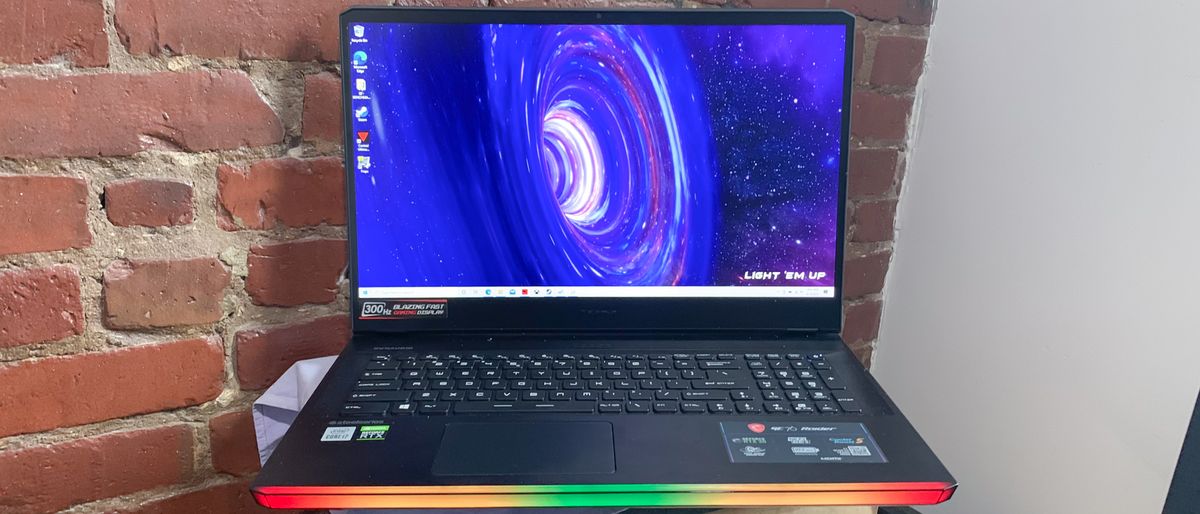Laptop Mag Verdict
The MSI GE76 Raider UH10 serves up plenty of power, speed and endurance in a slimmed-down chassis.
Pros
- +
Excellent overall and gaming performance
- +
Lightning-fast transfer speeds
- +
Powerful audio
- +
Wi-Fi 6 capabilities
Cons
- -
Dim, dull display
- -
Mushy keyboard
Why you can trust Laptop Mag
Price: $2,899
CPU: Intel Core i7-10870H
GPU: Nvidia GeForce RTX 3080/Intel UHD Graphics
RAM: 32GB
Storage: 1TB PCIe SSD
Display: 17.3-inches, 1920 x 1080p FHD
Battery: 6:06
Size: 15.6 x 10.6 x 1.1 inches
Weight: 6.4 pounds
It’s the Raider’s time now. As MSI puts its formidable Titan out to pasture, the GE76 Raider is here to fill that ginormous footprint. And it does a great job for the most part. A smaller, thinner version of the Titan, the Raider proves it’s every bit as powerful as its behemoth predecessor, bringing an Intel Core i7 processor and an Nvidia RTX 3080 GPU to the party. Plus, you get incredibly fast transfer speeds, solid battery life and great audio. And it’s one of the first gaming laptops to feature Wi-Fi 6.
But for $2,899, there are a few flaws to contend with, namely a mushy keyboard and a dim, dull display. However, that panel does have one of the highest refresh rates available. If you can overlook those slight imperfections, the MSI GE76 Raider deserves a place in your gaming battlestation as well as our best VR-ready laptops, best gaming laptops and best MSI laptops pages.
MSI GE76 Raider pricing and configurations
The MSI GE76 Raider comes in several configurations including my review unit which costs $2,899. For that price, you get a system with a 2.2-GHz Intel Core i7-10870H processor, 32GB of RAM, a 1TB NVMe SSD, an Intel UHD Graphics GPU, an Nvidia GeForce RTX 3080 GPU with 16GB of VRAM, and a 17.3-inch, 1920 x 1080-pixel display with a 300Hz refresh rate and a 3ms response rate.
The $1,499 base model has a 2.6-GHz Intel Core i7-10750H CPU, 16GB of RAM, a 1TB NVMe SSD, Intel UHD Graphics, an Nvidia GeForce RTX 3060 GPU with 6GB of VRAM and a 17.3-inch, 1920 x 1080-pixel display with a 144ms refresh rate. You can upgrade to 32GB of RAM, an RTX 3070 GPU with 8GB of VRAM, and a 1080p display with a 240Hz and a 3ms response rate for $1,999. For $2,299, you make the jump to a Core i7-10870H CPU.
And then there’s the $3,399 Tiamat special edition. It has a dragon-inspired design etched into the lid and the palm rest with gold accents. In terms of specs, it has a 2.2-GHz Intel Core i7-10870H processor, 64GB of RAM, a 1TB NVMe SSD, Intel UHD Graphics, an Nvidia GeForce RTX 3080 GPU with 16GB of VRAM, and a 17.3-inch, 1920 x 1080-pixel display with a 300Hz refresh rate and a 3ms response rate.
MSI GE76 Raider design
MSI put the GT76 Titan on a serious diet. At 6.4 pounds, the 15.6 x 10.6 x 1.1-inch Raider is considerably lighter and thinner than the 9.9 pounds, 15.6 x 12.9 x 1.3~1.7-inch Titan. It’s also lighter than the Alienware m17 R4 (6.6 pounds, 15.7 x 11.6 x 0.7~0.9 inches). However, the Raider is slightly heavier than the Razer Blade Pro 17 (6.1 pounds, 15.6 x 10.3 x 8 inches).
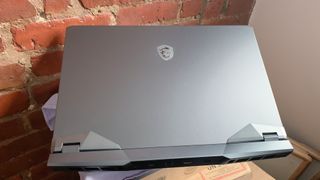
Dimensions aside, the Raider really does look like a skinnier version of the Titan. The lid is colored Titanium Blue, which looks more like a pewter to me, but go figure. The rest of the laptop is done in an inky black. The majority of the laptop is made of anodized aluminum with the hinges and rear vent constructed from plastic. Lucky, MSI’s trademarked dragon mascot looks downright majestic in the centrally placed crest at the top of the lid. Meanwhile, the raised angular hinges and vent mimic the appearance of the supercar I whip down the Autobahn in my dreams.
Opening the laptop is like a foggy evening giving way to the darkest midnight. Illuminated by the RGB backlighting, the keyboard looks like a colorful galaxy dotting the darkness that is the keyboard deck. The keyboard is sandwiched between a pair of vents with the touchpad directly below in a rather large palm rest. But similar to most Raiders, the piece de resistance is the thick RGB panoramic aurora lighting lining the front lip of the laptop. It gives the laptop a psychedelic Night Rider vibe that I’m digging.
MSI GE76 Raider ports
How many ports does the Raider have? Tons, oodles, a lot. Seriously, outside of some older legacy ports like VGA and Firewire, if you need to plug something in, the Raider’s got you covered. Along the right, you have a pair of USB 3.2 Gen 1 Type-A ports and a microSD card reader slot.



There’s a USB 3.2 Gen 2 Type-A port along the left with a USB 3.2 Gen 2 Type-C port and a headset jack. And just like a mullet, the party is in the back with another USB 3.2 Gen 2 Type-C port, an HDMI 2.0 port, a Mini DisplayPort 1.4, a Gigabit Ethernet port and a proprietary power port that I’m not too thrilled with, but c’est la vie.
MSI GE76 Raider display
The Raider’s 17.3-inch, 1920 x 1080-pixel display is a bag of tradeoffs. On one hand, you have a panel with a blistering 300Hz refresh rate and a 3-millisecond response rate. On the other, it’s not as vivid or bright as the competition. However, without one of the other systems around to compare, I couldn’t tell the difference.
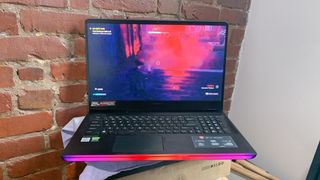
When I watched the trailer for Killer Among Us, the neon orange bra peeking out of actress Imani Lewis’s yellow, grey and black camouflage dress immediately drew my eye. As did her rose-gold color curls. Details were clear enough that I saw some of the sequins on her purse, and the paint peeling off the brick wall in the background.
Exploring the ever-shifting halls of the Oldest House in Control, the sterile background is suddenly painted in a lurid red as Hiss, once human beings, now ashen-skinned monstrosities glowing neon orange, appeared. I levitate a black leather couch and launch it into the approaching horde, causing several to explode into a cascade of blue energy orbs. The scene was even prettier thanks to the 300Hz refresh rate with a 3-ms response rate, which made for silky smooth rendering with hardly any latency.
I was disappointed to learn just how dull the Raider’s display is in comparison to its competition. The panel reached only 53.9% of the DCI-P3 color gamut which is woefully shy of the 89.7% premium gaming laptop average. The Blade Pro and the Alienware were both far more vivid at 83.9% and 80.6%, respectively, but still short of the average.
The Raider also came up short on the brightness test, averaging only 276 nits, below the 339-nit category average. The Blade Pro did only marginally better at 277 nits while the Alienware achieved 316 nits.
If you want to adjust the color temperature and squeeze a bit more vividness out of the system, MSI included its True Color utility. Comprised of five presets (Gamer, Anti Blue, sRGB, Office and Movie), each is designed to deliver optimal viewing depending on the lighting situation. Overall, I preferred Gaming as it produced better hues than the other settings.
MSI GE76 Raider audio
The last few MSI systems I’ve reviewed have been a bit shaky on the audio front. Not here. MSI and Nahimic are back to form, pumping out loud, detailed audio through the laptop’s side-mounted speakers. When I listened to Randy Crawford’s “Street Life,” the speakers filled my smallish living/dining room space. The volume is on a par with a mid-tier speaker.
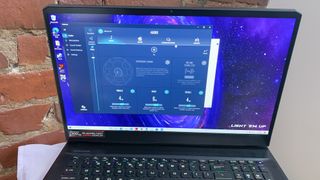
With the Music preset enabled in the accompanying Nahimic software, there was clean separation between the bass guitar and acoustic guitars as well as the horns and the violins. The vocalist’s tale of fast times and hard living carried across the room and the piano solo had the expected joie de vivre.
Still, out of the four settings (Music, Movie, Communication and Gaming), I preferred Movie as it adds the software’s Surround Sound technology to the mix, bringing warmth and depth to whatever I listened to. Nahimic also added a new Sound Sharing feature that allows you to share your audio with a friend via a pair of wireless headphones or a wired pair via the audio jack or USB. Plus, you get Sound Tracker, which cues up a HUD that signals where a sound is coming from in relation to your position on the map. It’s a handy feature when you’re playing an FPS or any game where someone or something can potentially get the drop on you.
Speaking of gaming, I was constantly on edge as I played Control. Whether it was a steam pipe suddenly bursting or that eerie, nonsensical chat of Hiss, the Raider delivered every sound with crystal-clear clarity to my chagrin. And when it was time to fight, the ominous fight music never overshadowed the explosions and resulting death gasps of the enemy.
MSI GE76 Raider keyboard and touchpad
In addition to its full-size, island-style keyboard, the Raider has a full numpad without sacrificing key size or spacing. However, the keys are a bit mushy for my liking, lacking the snapback actuation that I prefer. Still, I reached my usual 70 words per minute when I took the 10fastfingers typing test.
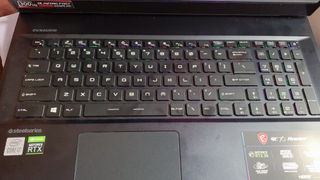
Like most premium gaming laptops, the Raider has customizable per-key RGB lighting. As usual, MSI uses the SteelSeries Engine 3 software to get the job done. If you’re not in the mode to create your own illuminated masterpiece key by key, SteelSeries has 11 presets at the ready. The same goes for the panoramic Aurora lighting that is broken down into 30 separate sections in the app. And like the keys, the light strip can now also be adorning in over 16.7 million hues. The software is also where you can record and map macros.
And as much as I enjoy a good RGB light show, you can really only enjoy the full beauty of the Raider with the lights off. If I play in a particularly sunny space or with the lights on, I lose out on the key glow.
MSI GE76 Raider graphics, gaming and VR
What’s a dragon without its fiery roar? A giant lizard, which might still be imposing, but is nowhere as much as the fire-breathing mythical beast. The Raider’s power and flame come by way of the Nvidia RTX 3080 GPU with 16GB of video memory which is not to be trifled with.
I fought to the Containment section of the Oldest House, slinging furniture and pieces of the architecture at waves of Hiss. And when that didn’t thin the herd fast enough, I unleashed the Shatter version of the Service Weapon and blew several of my foes away at 52 frames per second on High at 1920 x 1080. The frame rate jumped to 61 fps on Medium.
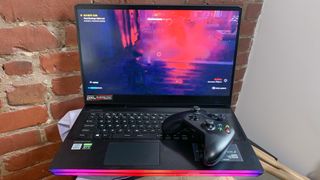
Throughout our synthetic benchmarks, the Raider was constantly at battle with the Alienware which has its own 3080 GPU while the Blade Pro, with its RTX 3070 card, delivered respectable numbers. For instance, the Raider scored 73 fps on the Assassin’s Creed Odyssey test, coasting past the 63-fps premium gaming laptop average and the Blade’s 68 fps. However, the Alienware managed to score a few more frames at 78 fps.
The Raider and the Alienware tied at 120 fps during the Grand Theft Auto V benchmark, beating the 91-fps average and the Blade Pro’s 102 fps. On the Metro: Exodus RTX benchmark, the MSI reached 77 fps while the Alienware hit 78 fps. Both scores flamed the Blade Pro’s 61 fps and the 57-fps category average.
When we ran the Far Cry New Dawn benchmark, the Raider reached 90 fps, defeating the 88-fps average and the Blade Pro (89 fps), but not the Alienware, which achieved 105 fps. It was another close call during the Borderlands 3 test with the Raider obtaining 100 fps to the Alienware’s 102 fps. The average and Blade Pro hit 70 and 79 fps, respectively.
And if you’re worried about the Raider holding its own while running VR applications, don’t be. The laptop produced a score of 3,706 on VRMark Blue, the most taxing benchmark. It trounced the 2,564 average, but came up just a bit short of the Alienware which reached 3,710.
For those moments where you’re doing actual work, like say, writing a review in Google Docs, the Raider switches over to its integrated Intel UHD Graphics to conserve energy.
MSI GE76 Raider performance
Le sigh. As I mentioned in the previous section, there came a time when I actually had to do some work on this glittery beast. And when I did, the Raider’s 2.2-GHz Intel Core i7-10870H processor with 32GB of RAM and a 1TB NVMe SSD handled my many tabs with graceful aplomb. I had 50 tabs open, a gnarly mix of GDocs, Sheets, YouTube, Twitch, Tweetdeck, Google Analytics, Facebook, and Netflix and the laptop still streamed the latest version of Falcon and the Winter Soldier without breaking a sweat.
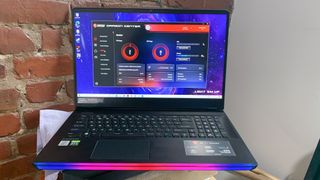
The Raider did a fine job on our artificial tests such as Geekbench 5.3, an overall CPU performance test, where the laptop hit 7,612. That was enough to scorch the Blade Pro (Core i7-10875H CPU, 6,144) and the 6,707 premium gaming laptop average. However, the Alienware and its overclockable Core i9-10980HK CPU dominated with a score of 8,082.
During the Handbrake video transcoding test, the Raider transcoded a 4K video to 1080p in 7 minutes and 24 seconds. It couldn’t outpace the Alienware which delivered a time of 6:44, but it was much faster than the 8:07 average and the Blade Pro’s 10:10.
On the file transfer test, the Raider produced a transfer speed of 1,076.8 megabytes per second. It absolutely destroyed the challengers with the Blade Pro (512GB PCIe NVMe SSD) and Alienware (dual 1TB PCIe m.2 SSDs) reaching only 547.2MBps and 448.5MBps, respectively. The Raider also surpassed the 840.8MBps category average.
MSI GE76 Raider battery life
Since the Raider offers several power modes, we ran the Laptop Mag Battery Test (continuous web surfing over Wi-Fi at 150 nits of brightness) several times.
In Super Battery Mode, the laptop achieved a time of 6 hours and 6 minutes. In Extreme Performance Mode, that time dropped slightly to 5:20. The former result was enough to outlast the 4:30 premium gaming laptop average as well as the 5:58 posted by the Blade Pro and the 2:05 achieved by the Alienware.
It helps that MSI started outfitting its gaming laptops with a 99.9Whr battery, the largest the TSA will allow aboard an airplane.
We also tested the Raider’s endurance while gaming and saw times of 1:52 and 1:49 in Super Battery and Extreme Performance Modes, respectively.
MSI GE76 Raider heat
I have to say, I’m impressed with how cool the Raider stays when gaming. MSI Cooler Boost 5 technology offers two dedicated fans and six copper heat pipes strategically placed to disperse as much heat as possible. Is it going to get below our 95-degree Fahrenheit comfort threshold? No, but it got pretty close.
After playing a game for 15 minutes, we measured strategic points on the Raider’s frame. The touchpad and center of the keyboard registered 73 and 84 degrees, respectively. Meanwhile, the bottom reached a warm, but surprisingly not hot 108 degrees. I say this after playing Control for an hour with the system in my lap.
We let the notebook cool down and ran a 15-minute FHD video at full screen and measured again. The touchpad, middle and undercarriage had results of 74, 83 and 88 degrees, respectively.
MSI GE76 Raider webcam
Why can’t all integrated webcams be like this one? The Raider has an excellent 1080p shooter integrated in that top bezel. It’s so good that I don’t even have to recommend buying an external webcam. The cam did a great job of capturing the exact shade of mustard in my shirt without losing the thin, white stripes. My skin tone seemed to glow and outside of my houndstooth-pattern couch, which most cameras have difficulties getting right, everything in the background had great definition. You should have no problem using this webcam to stream or do video conferencing.
MSI GE76 Raider software and warranty
MSI bundled all of its gamer-centric utilities into Dragon Center for one-stop access. It’s here that you can monitor system diagnostics, perform light maintenance, and switch between fan and power profiles. You can also enable/disable the Windows Key, the webcam and the Crosshair display if you don’t care to fiddle with the Fn keys.

The company also added a few more goodies designed for streamers, such as MSI Sound Tune. An AI-powered noise-cancellation technology, Sound Tune works to automatically filter out background noise to prioritize voice, which comes in handy when you’re narrating your latest exploits or just sitting in on a video call. There’s also Duet Display that allows you to game on the main display while capturing important data i.e. maps and inventory on a second connected monitor.
There are also several third-party apps designed to enhance gaming performance, including Killer Control Center, which prioritizes network bandwidth to data-intensive software. I usually don’t go too deep into connectivity, but it should be noted that the Raider is one of the first laptops to feature Wi-Fi 6. The laptop also comes with Nvidia GeForce Experience, which has its own set of helpful functions, including Battery Calibration, Game Optimization, Whisper Mode and In-Game Overlay.
In case you’re looking to do some content creation, the Raider has software from the Cyberlink suite including AudioDirector, ColorDirector, PhotoDirector 10 Essential, PowerDirector 17 Essential and MusicMaker Jam.
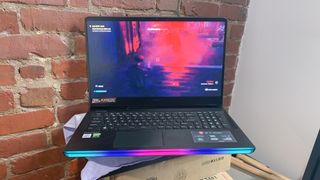
The notebook does have some bloatware including Roblox, Hulu and Hidden City: Hidden Object Adventure.
The MSI GE76 Raider comes with a 1-year limited warranty. See how MSI fared during Tech Support Showdown and Best and Worst Brands, our annual special reports.
Bottom line
Performance, endurance and RGB lighting, the MSI GE76 Raider gives me everything I love about a gaming laptop. Armed with a Core i7 processor and Nvidia’s monstrous RTX 3080 GPU, the laptop’s power cannot be denied. And depending on what mode you’re using, the Raider’s battery can go the distance. On top of that, it’s got excellent audio, blistering-fast transfer speeds, and is one of the first gaming laptops to feature Wi-Fi 6.
However, for $2,899, I wish the screen and the RGB backlighting were a little bit brighter and more vivid. The keyboard could also be springier. The $3,389 Alienware m17 R4 hits all those points and manages to nudge out the Raider ever so slightly on our gaming and overall performance tests. However, if you want performance, style and solid battery life in a relatively portable gaming laptop, the MSI GE76 Raider should sit at the top of your list.
MSI GE76 Raider UH10 Specs
| Size | 15.6 x 10.6 x 1.1 inches |
| Display | 17.3-inches, 1920 x 1080p FHD |
| CPU | Intel Core i7-10870H |
| Price | $2,899 |
| GPU | Nvidia GeForce RTX 3080/Intel UHD Graphics |
| Battery | 6:06 |
| Weight | 6.4 pounds |
| Storage | 1TB PCIe SSD |
| RAM | 32GB |

Sherri L. Smith has been cranking out product reviews for Laptopmag.com since 2011. In that time, she's reviewed more than her share of laptops, tablets, smartphones and everything in between. The resident gamer and audio junkie, Sherri was previously a managing editor for Black Web 2.0 and contributed to BET.Com and Popgadget.
